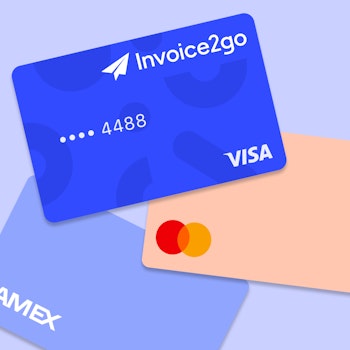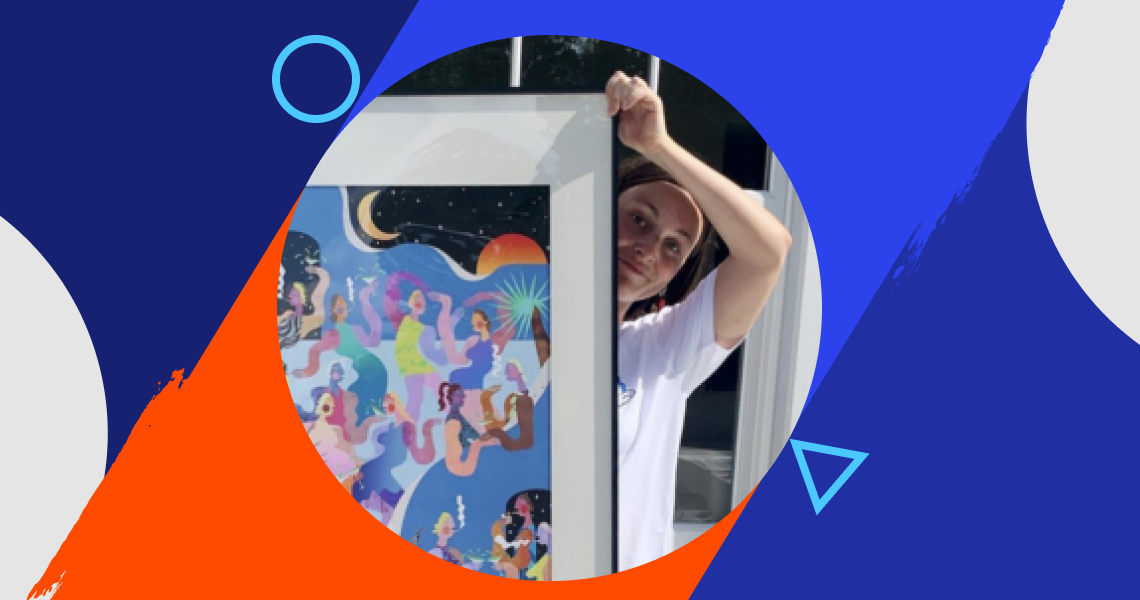
Invoice2go Artists: Q&A with Imogen Crossland
The past two years have pushed many of us to our brink. We grieved everything the pandemic took from us – human lives, time with loved ones, and our old routines, to name a few – all while grappling with the anxiety of not knowing when, or if, we’d return to normal.
Imogen Crossland’s art offers a sunny reprieve from the COVID gloom. “Celebrating colour, joy and togetherness, my work is an ode to the good times,” the UK-based freelance illustrator explains on her website. Her vibrant, swirling digital collages immerse viewers in the moments she missed most during lockdown – dancing, partying, and simply being with other people.
Imogen, or “Imo” for short, creates her digital collages with handmade materials, such as drawings, paintings, textiles, and scraps of paper. She leafs through her sketches with us over Zoom, which range from multi-colored polka dots to puffy white clouds against a blue sky. “That’s what I do, just to get that texture and materiality in it, so it’s not too digital,” says Imo, who illustrated our article on small business tax deductions. “Then I play around with it and hopefully have something alright at the end.”
As exuberant and expressive as her art, Imo has taken a similar try-and-see-what-happens approach to her freelance career – and it’s clearly paid off. Since she graduated from the University of Brighton with a degree in Visual Communications in 2020, her illustrations have appeared on Tate billboards throughout London, in Pirelli’s 50th anniversary magazine, and in WeTransfer’s WePresent. She was also a winning artist in the 2020 TDK Awards.
But as free-spirited as Imo might seem, she maintains a highly disciplined practice, treating her work as she would a traditional office job. She chatted with us from her basement-turned-studio about her freelance beginnings, imposter syndrome, and her Zen-like philosophy on creative blocks.
How did your artistic journey start?
I was always drawing as a kid. I remember being really young, drawing on my Barbies, drawing on paper, drawing with felt tips dipped in loads of PVA glue. I was good in art class, as well. But I never really thought I could do art as a career. I didn’t know anything about illustration, really, because I’m not a traditional illustrator. All I knew of illustration was Quentin Blake, who illustrated the Roald Dahl books, and I was like “That’s not me.” All I knew were painters, and I was like, “I’m not a painter” (although, admittedly, parts of my style heavily involve paint).
I wasn’t even planning on going to go to art school. I was actually going to study French and Spanish at a university in London. My parents really, really didn’t want me to study art, which I can’t blame them for because it is unstable. I remember my high school art teacher getting a bit emotional at the idea that I wasn’t studying art at uni.
I was supposed to start the university course for languages in September 2016, and I think it was around July when I was like, “I’m not going to go!” I ended up doing illustration at the University of Brighton instead. But for a long time, I felt completely out of my depth. It wasn’t until my third year that it started coming together, and I was like, “Ok, I can do this.”
Who are your artistic influences?
Oh God, I have so many. Because I digital collage, I make my work using so many different techniques, which means I’m inspired by so many things. I love artists like Matisse and Picasso, who have more illustrative flair, but I also love abstract artists. And I love photographers, too.
But as far as modern illustrators, whenever anyone asks who inspires me, I always reference Kelly Anna. Once a week at uni, people working in the industry who were doing a pretty good job would give a lecture. At this point, I wanted to drop out every week. And then Kelly Anna spoke to us, and I realized the huge scope of her career. She was designing clothes, doing murals, working with massive brands like Nike. She’s probably my number one inspiration, career-wise, because she's got her fingers in all the pies. It’s just like, “Oh my God, I want to be like her.”
What led you to pursue a freelance career over a 9-to-5 in illustration?
In uni, I never had the confidence to think I could do it on my own. I just wanted the security of an in-house job. But then at the end of the year, the teachers offered us one last Zoom call to give us post-grad advice. My teacher asked what I wanted to do after graduation. I said, “I guess I’ll just go and work for a brand.” She’s like, “You’re joking. Your work isn’t very malleable. You’ve got this style to your work. You can’t go and work for whatever brand you want. Your art is your art.” And then it became very obvious to me then, like, God, of course that’s not for me.
I think because I graduated during COVID, everything was on pause, which meant I wasn't rushing to get a job. I didn’t feel pressure to make and send work. It gave me the time and space to fall into freelancing. And because I’ve had the financial security of living at home, I’ve gotten the opportunity to really develop as an artist.
How did you start landing clients?
Thankfully, work was coming to me – people found me through Instagram. I’ve always posted on Instagram. I’ve got around 2,000 followers and they’ve just been dribbling in, bit by bit. I guess the main strategy I use to attract people is being consistent with posting because that’s how the algorithm increases your reach. I think that’s been a big help.
Because the work comes to me, it’s completely random. I get some editorial work, and I’ve just done a job for the Flower Council of Holland. I love that I get work from all sorts of places, because it challenges me. You don’t want to stay too comfortable.
But I know I can't just rely on Instagram. I really want to use my time this year to ask myself, “If I could work for anyone, who would I work for?” My plan is to send nice little postcards of my work to studios and be like “hire me.” I need to be more proactive about sending my work to potential clients. I just never felt ready, which is silly, because I am.
How do you structure your workweek?
I treat my work like a 9-to-5, or 8-to-whenever it has to be done. The other day I woke up at 3:45 a.m. to meet a deadline, and I work a lot of weekends. I'm really bad at stopping myself from working, but it’s because I love it, and it doesn't feel like a chore at all. I’m quite disciplined with it, and I think you have to be because it’d be so easy to just knock it off on a day you don’t feel like doing it. My rule is to never miss a Monday, even if you’re hungover or had a big weekend.
Sometimes my friends will ask me to hang out when they have a day off. Because my work is on my terms, they probably think I can do whatever I want. I’m like, “No, absolutely not” – although one of the perks of freelancing is that if there is something I really want to do, I can. But I want to put my all into my work, and I want to treat it as if I’ve got someone to answer to.
Do you ever run into creative blocks? If so, how do you deal with them?
All the time. A year ago when I'd get them, I’d just freak out. I’d think to myself, “What am I doing with my life? I need to stop doing this now.” I’d let myself believe what my little brain was telling me. But over time, I’ve begun to see the patterns of creative blocks, and then feeling really good about my work. So now whenever I have a creative block, I really try to remember when I was feeling positive about my work because then it’s just like, this happens. It’s just a cycle. I don’t allow it to make me think I'm rubbish anymore.
Sometimes I work through it. Sometimes I deal with it by not overthinking. I might put on a song and come up with an idea from that. I try to relax and remember that not everything needs to have this big purpose. Just make the art and chill out. Keep creating through it, and eventually something good will come out of it. And I do think you have to make bad work to make good work.
What other challenges have you faced as a freelance illustrator, and how have you overcome them?
People don't understand or respect illustration. For a long time, I would want to burst into tears whenever people asked what I did for work, because I knew they didn’t get it and were like, “She needs to get a proper job.” I hate that.
I don’t feel embarrassed anymore. It’s really cool what I do. It makes me happy, and I love every day I get to do it. We need to get rid of this idea that if you enjoy your work, it must be easy. I have a friend in my field who gets it, and we always confide in each other about the time, effort, and energy that goes into our work.
Gaining a bit of success boosted my confidence. I’m a big one for doubting myself and catastrophizing everything, and I think I’ve just learned to look objectively at what I’ve done. I’d say to remove your emotions, any of that stuff. You’re doing well. You’re making money. If you are making money from something, that is a job.
You’ve described your work as an homage to “color, joy, and togetherness.” Why is it important for you to celebrate these themes, especially now?
It’s just everything I love. Just making it makes me feel closer to it. There were so many people in my uni course who had such a strong sense of what they were making, who they were, and I still didn’t know. Then in lockdown, I just started making work about the things I was missing. I’m obsessed with dancing, so I said to myself, “I’m going to make work about people dancing and drinking and just being together.” It just stuck. I was like, “Right, this is my thing now.” And I haven’t stopped. It just makes me happy. It’s just what I do.
Related Articles
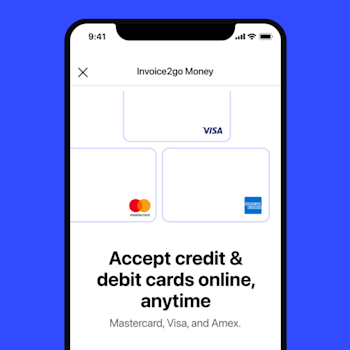
How to accept credit card payments on Invoice2go in 3 simple steps
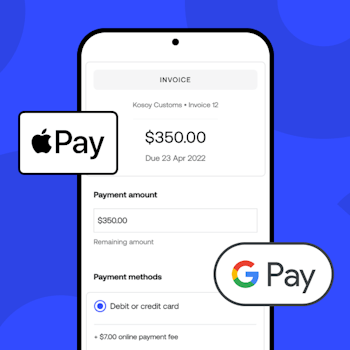
Accept payments online via Apple Pay and Google Pay

Must-not-miss write-offs as you wrap up 2022 year-end finances
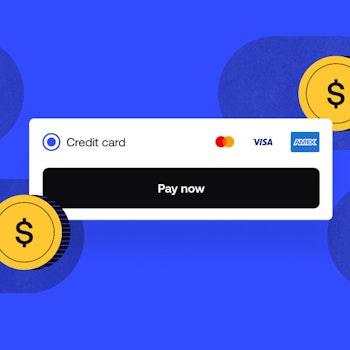
5 ways accepting credit and debit card payments helps your business stay resilient

4 easy ways to increase cash flow today

What is Small Business Saturday and why is it important?
The features and surprising benefits of a well-designed packing slip
